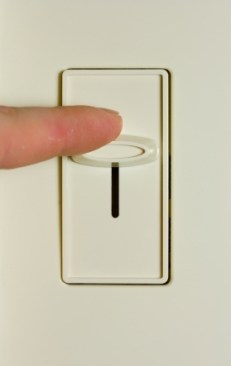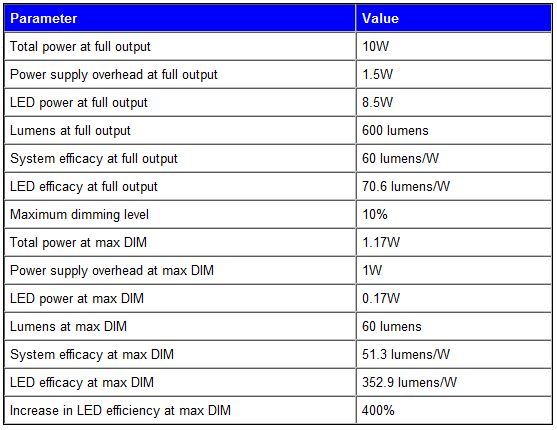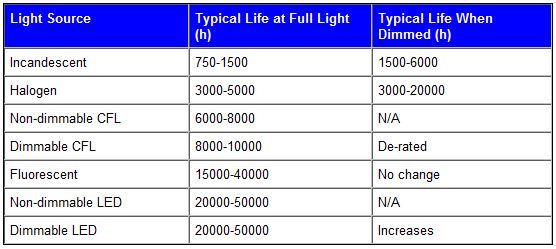
Integrated LED Replacement Lamps and Existing Dimmers: Compatibility Issues
With more than 4 billion incandescent lamps installed in homes, retrofit represents the biggest opportunity for LED technology in residential applications. Currently, directional LED replacement lamps are beginning to offer suitable alternatives to directional incandescent lamps, and manufacturers are working on viable replacements for omnidirectional incandescent lamps. LED technology has the potential to offer significant benefits to consumers, such as energy savings, no radiated heat or ultraviolet output, no contained mercury, and long service life.
An issue of critical importance will be compatibility with the large installed base of lighting controls. It is estimated that there are some 150 million incandescent dimmers installed in American homes. Consumers value high-performance dimming, which offers the benefits of energy savings and mood setting. Additionally, application of energy-saving vacancy sensors continue to increase, driven largely by the Title 24 energy code.
Aside from poor performance with some low-end motion sensors, switching usually does not present any issues; well-designed integrated LED lamps turn ON and achieve full brightness instantly, making them friendly with switches, and frequent switching does not affect lamp life, making them friendly for use with vacancy sensors.
At first glance, LED technology appears to be very friendly with dimming control, with dimmable integrated LED lamps available. However, the given integrated lamp must be rated as compatible with the given line-voltage dimmer.
This whitepaper describes current LED dimming issues and offers application guidance to avoid unwanted performance.
Dimmer operation and user expectations

may receive several potential pos-
itive benefits from dimming.
Line-voltage dimmers, typically forward phase-cut devices due to their simple design and economical cost, turn incandescent lamps ON and OFF 120 times per second, imperceptibly to the naked eye, usually with an electronic device called a triac switch. The dimmer enables the user to alter the proportion of ON time to OFF time, raising or lowering average voltage and resulting lamp power and light output.
Many users’ visual performance expectations have been shaped by their experience with dimming incandescent lamps, and therefore should be taken into account when evaluating the dimming performance of an integrated LED replacement lamp. Incandescents, for example, can be dimmed to very low light levels, with dimming range expressed as a percentage of the full light output level, and the lamps started at the minimum light level setting. Light level changes smoothly and quickly, without flicker or shimmer effects. A group of lamps operated by a single dimmer will dim uniformly. The lamps and control will make very little noise. And the lamp will become “warmer” in color tone at lower light levels.
Dimming and LEDs
Integrated LED replacement lamps may receive several potential positive benefits from dimming. For example, unlike compact fluorescent and incandescent lamps, LEDs produce light output that is proportional to electrical input. An LED operating at 50 percent of its initial rated power will produce about 50 percent of its initial rated light output. Towards the lower end of the dimming range, efficacy actually increases, the result of dimming lowering internal temperatures in the LED device and thereby increasing its light output. For example, as shown in Table 1 below, a sample LED product, which can dim from 100 percent to 10 percent of full output, experiences a dramatic increase in LED efficiency at its maximum dimming level.

Meanwhile, dimming may extend LED product life. Unlike compact fluorescent and incandescent lamps, integrated LED lamp life is based on lumen maintenance—specifically L70, or the point at which the lamp is producing only 70 percent of its original light output (general lighting) or L50, at which the lamp is producing only 50 percent of its original output (decorative lighting). Because reducing LED internal temperatures increases light output, the LED product’s useful life is likely to be extended, as show in Table 2 below. Additionally, high operating temperatures can cause a color shift towards blue among most white LEDs as their phosphors fail; by reducing temperatures, this color shift can be delayed.

Compatibility issues
Not all LED replacement lamps are compatible with all existing dimmers, and not all lamps are even compatible with dimming at all. Some lamps are line-voltage AC LED products that do not use driver circuits or power supplies, and work directly on 120VAC power and with compatible existing dimmer controls, but may present a risk of flicker. Other lamps contain integrated drivers and power supplies, which provide required current at a high frequency and thereby enable dimming with minimal flicker. The driver may be a constant current or voltage device; constant-current drivers regulate current and allow output voltage to adjust, while constant-voltage driver regulate voltage regardless of the current drawn by the load. Constant-current drivers are generally recommended for integrated LED replacement lamps. For the product to be dimmable, the driver must be designed to interpret control signals and produce a range of LED current; the added control circuitry and broader current range can produce higher energy savings but with a tradeoff of lower driver efficiency. As LEDs are still a young technology and standards are still being developed, selecting LED replacement lamps and matching them with existing dimmers should be approached with caution. LED lamps and controls should be verified as compatible (assume they are not until proven otherwise). Any chosen product should meet safety performance requirements as well as power quality and industry standard specifications. The driver should have a rated life comparable to the LED array (20,000 to 50,000 hours). If layering dimmable and non-dimmable LED lighting in the same space, these different systems may age differently, resulting in diverging light output levels and degree of color shift. Because light output increases at the low end of the dimming range, the light output and dimmer setting may drift out of proportion at this low end. And because incandescent line-voltage dimmers are designed specifically for incandescent lamps, their requirements—such as constant leakage current path, minimum load, resistive impedance, which are met by most incandescent lamps—must be met by the given LED product, or else the product may flash, flicker, not turn ON or operationally fail.
Ask the right questions
Below is a list of questions to ask when evaluating compatibility between given dimmers and integrated LED replacement lamps:
- Are all components in the system rated as compatible and supported by their manufacturers?
- Has the system’s particular component combination been tested to ensure it will work as specified?
- What is the maximum dimming level of the lamp?
- Is the relationship between the dimmer control position and light output known?
- What is the maximum load allowed by the dimmer? Is there a minimum load requirement?
- Does the LED product turn ON at all dimming levels of the dimmer?
- Does the LED product turn OFF or “cut out” during the travel of the dimmer?
- Is there noticeable flicker or stroboscopic effect when the LED product is dimmed?
- Is there any color shift when the LED product?
- Does the dimmer make audible noise during dimming the LED product?
Many of these questions are related to a device designed to dim incandescent lamps being used to dim LED lamps. In short, incandescent lamp dimmer reliability is ensured if each of the stresses when the dimmer drives non-incandescent loads is less than the stress when the dimmer drives the rated incandescent load.
For more information:
These and other compatibility issues are covered in greater technical detail in a whitepaper recently published by the National Electrical Manufacturers Association (NEMA): LSD 49-2010 Solid State Lighting for Incandescent Replacement: Best Practices for Dimming, produced by the organization’s Solid State Lighting Section. This whitepaper provides recommendations for the dimming and design of screw-based incandescent replacement solid-state lighting products. The main object of the paper is to encourage coordination among control, power supply and LED module manufacturers to achieve desired performance and product harmonization throughout the market. The paper is a precursor to a NEMA standard that will provide metrics for evaluating LED dimming compatibility and performance.
Download LSD 49 at no cost by visiting www.nema.org/stds/lsd49.cfm.
By Craig DiLouie

